Announcing the 2025 Science Discovery on Main Street Implementation Grantees
Meet the seven grantees of the 2025 Science Discovery on Main Street Implementation Grants!

Marion, Iowa © Tasha Sams
We work in collaboration with thousands of local partners and grassroots leaders across the nation who share our commitment to advancing shared prosperity, creating resilient economies, and improving quality of life.

Emporia, Kansas © Emporia Main Street
Made up of small towns, mid-sized communities, and urban commercial districts, the thousands of organizations, individuals, volunteers, and local leaders that make up Main Street America™ represent the broad diversity that makes this country so unique.

Chicago, Illinois © Main Street America
Looking for strategies and tools to support you in your work? Delve into the Main Street Resource Center and explore a wide range of resources including our extensive Knowledge Hub, professional development opportunities, field service offerings, advocacy support, and more!

Waterloo, Iowa © Main Street Waterloo
Your one-stop-shop for all the latest stories, news, events, and opportunities – including grants and funding programs – across Main Street.

Kendall Whittier — Tulsa, Oklahoma © Kendall Whittier Main Street
Join us in our work to advance shared prosperity, create strong economies, and improve quality of life in downtowns and neighborhood commercial districts.
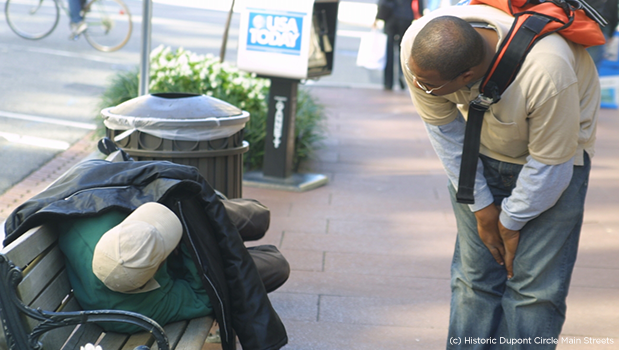
Jonathan (right) works with the DC Government now, and used to work for Pathways to Housing assisting people in getting an apartment and wraparound services.
Main Street America is committed to helping build inclusive communities. Homelessness is an increasingly important issue facing Main Street communities big and small, urban and rural. Though undoubtedly a complex issue and one which no single program can fully address, Main Street programs can take a proactive approach, focusing on relationship-building and strategic partnerships with nonprofits and businesses. In this essay, Main Street manager Bill McLeod shares his own strategies to help homeless individuals. *All images in the article were taken with, and are being shared with, express permission of the individuals photographed.
First, I want to clarify that I am a Main Street manager and not a social worker. This article isn’t about “getting rid” of homeless people. It is about lessoning the burden homeless people face, and perhaps improving the relationship you and your merchants have with homeless individuals you see regularly. I don’t profess to have all the answers, but I can help someone outside my door.
The first step in working with homeless individuals is to assess the issues at hand. Most people agree that no one should have to live on the streets. But, you’re still fielding complaints from the community. So what is the real issue community members and merchants have with the homeless? Is it that some people panhandle? Appear disheveled? Struggle to maintain hygiene? Whatever it is, you need to assess what the real and perceived problems are in order to address them.
Next, assess who is being affected by the behavior. Are merchants complaining? Are tourists frightened? Or, are residents frustrated? After you have a better understanding of what the issues are, you can seek solutions. Once you start thinking about partnerships and possibilities, things really can improve.
The final part of an assessment is to do a homeless count. I recommend a late night count, starting at 11:00 p.m. This will truly give you clues to how many people you have and where they are sleeping. (A simple assessment involves counting numbers and noting locations.) Or, you can be more daring and ask people their names, record conditions, and ask some questions. Keep it simple the first time. Once the first homeless count is done, you know what you are working with and can expand it the next year.
Sadly, often time when people complain about homeless individuals, it is because of people’s appearance, and not their behavior. In our neighborhood, a number of people come to Dupont Circle’s park to hang out, sit with their friends, listen to oldies on a boom box, and play chess. They are not homeless, but some people think they are. That is a perception issue, and the best thing you can do for these people who complain is educate them. Public places are just that—public.
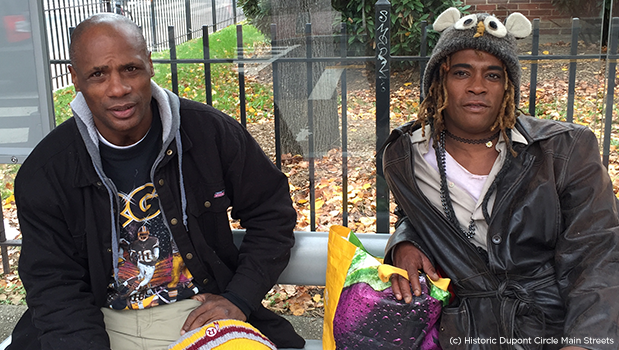
Mark and Chase can often be found around Dupont Circle. Mark lives with his daughter.
Some towns have small budgets that don’t include homeless outreach or social workers. If that’s the case, you will have to partner with the private sector and institutions to do most of the heavy lifting. (I’ve found that the private sector and nonprofits are the quickest to react to a call to action to help the homeless.) Perhaps you could start with a dry cleaner or laundromat donating laundry services every morning from 7:00-8:00 a.m. Or, find a barber shop willing to give free haircuts every Tuesday. Work with the parks department to create a well-managed public bathroom with a bathroom attendant. Work with the city to end the sales of tiny bottles of liquor or single beers. Whatever your issue is, be creative and come at it from different angles.
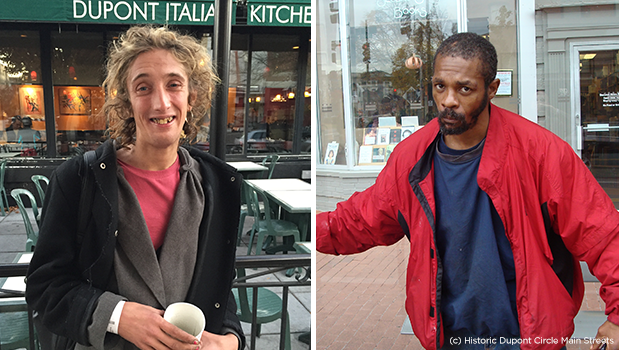
(Left) Alice was recently housed through Housing First. However, she enjoys the area and can still be found on the sidewalks in the morning. (Right) Dennis is a veteran, so he tapped into housing through Veterans Affairs.
If your city has no or little homeless services, you may have to educate the city council and mayor about the number of homeless and advocate for services needed, based on your assessment. If you have private service providers, you can support them through fundraisers, public awareness, and partnerships.
Ideas for how to address issues facing the homeless in your community with partnerships:
Hunger. Work with hotels or restaurants to organize a seven-day-a-week feeding program with one hotel or restaurant each day partnering with a church or nonprofit. Seven restaurants and seven institutions is not too much to broker.
Clothing. Work with a retailer or churches to create clothing closets for individuals to use. Goodwill and Salvation Army can be great partners.
Laundry. Work with dry cleaners and laundromats to offer free washing one day a week. You may be the one reminding homeless individuals about this free service. Make a basic flier, pass it out, and repeat the message.
Hygiene. Many churches downtown have shower facilities. If not, write a grant to install one in a nonprofit that also has a feeding program.
Haircuts. Work with a barber that will donate two hours a week and set up temporary shop in a food or washing facility to address messy hair and unshaved beards.
Physical Health. Work with minute clinics and local doctors to offer free medical assistance one day a week—ideally at a breakfast feeding program.
Mental Health. Get a social worker out there on the street with funding through the city or a nearby hospital. Sometimes all it takes is you making the connections, and you maintaining the relationships.
Drug or Alcohol Addiction. This is huge, and will take more than meetings at AA or NA to repair. Best to leave this to social workers, too.
Lack of ID. Access to food stamps, VA benefits, or other things require government IDs. Get an office to provide a one day a week drop-in center to work with individuals to get IDs, such as Social Security Cards, state ID cards and drivers licenses, etc. Once people get identification, they can apply for other government programs.
Veterans. Many homeless individuals are veterans. Luckily, Veterans Affairs has tremendous resources now for housing, counseling, medication, laundry, etc. Get to know all the homeless in your community to find out who has served in the military, and then work with the VA to get them help. In doing so, you will have to work with a federal agency, so roll up your sleeves and get to work, and prepare to manage this over the long haul.
Unemployment. Work with a job training program in your town or county. This can take a lot of work, so be realistic, brace yourself, and under-promise. Getting someone off the streets and into job training can be tough.
Housing. Housing is the most expensive thing on this list. The old model was to house low-income people all together in tower blocks. That didn’t work. Hope VI, the new model, is to mix housing up where low, moderate, and market rate people all live together. Work with your city and developers to require 10-20% of new units built be set aside for low and moderate income people—either rental or condo.
“Housing First” is the new approach for assisting homeless individuals. The theory is that once someone is housed, they become stable, and then you can address their needs through wrap-around services. When someone feels safe, they will take their medicine regularly, eat regularly, sleep regularly, and go to counseling, if needed. I’ve seen the dramatic improvement from the Housing First approach firsthand on three occasions in my neighborhood.
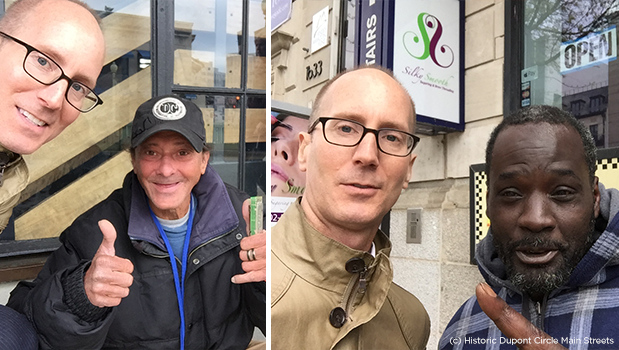
(Left) Here is a selfie with Robin, who no longer sells painted rocks in front of Starbucks. He has his own apartment thanks to Pathways to Housing. (Right) Wedel is working on getting housing, and he looks great with his new haircut, thanks to a discount from Hair Cuttery.
Scroll all the way down for examples of partnerships in Historic Dupont Circle Main Streets.
Yes, you already wear many hats in your job and perhaps “Homeless Outreach” wasn’t one you were expecting to don. Below are a few of my tips and tricks to get started building relationships through personal outreach.
Take time to talk. Building relationships can be tough at first. Homeless individuals may be skeptical of you because they don’t know you. Take some time to walk around to be visible. Walking and saying hello can open doors; sitting and starting a conversation can be transformational. I’ve found that when you talk with people, be friendly, but not their friend, generous, but don’t give money, and helpful, but not to a fault.
I’ve learned that often times I am viewed as “the man” or “the enemy” by people who don’t know me. I have found that bringing someone with me, such as a volunteer who looks different from me, is the best way to reach out to people I don’t know.
Once you have built a relationship with someone you can ask them a question – one question and no more. I usually ask a person their name, and that is it. Then, once I remember their name, conversations can start. You would be amazed how important it is to people to sit with them and talk.
Share. This past summer, I used bottles of water to greet and meet people in the park. On hot days, I gave out water and pretzels with a volunteer, and then gave out heat advisories about how high the temperature would be that day and where anyone can go to get cool, such as a public library, city building, or courthouse. (More homeless people die in the heat of the summer than the cold of the winter.) In winter, you can hand out gloves, coats, and blankets, and warn everyone about a blizzard coming. Small things like this really do build relationships (and can save lives).
After committee meetings, I pass out left over pizza. And if I have a few extra dollars, sometimes I go to Krispy Kreme Donuts, buy a dozen, and pass them out.
Publicize available services. I’m often surprised that word of services don’t spread how I think it should. Last year, I connected a church that had a Sunday feeding program with one of our well known Greek restaurants. The restaurant gives day-old food to the church to serve on Sundays for lunch. I then publicized it to the people in the park. I keep a list of services (that can be updated easily) of who is doing what in the neighborhood, so I can pass out basic fliers.
Ask questions. After we have a relationship and they feel comfortable, I ask people if I can take a “selfie” with them, which seems to evoke a smile. Because we are taking a picture together, it is less threatening than me taking a picture of them. I am not sure why this works, but it does. Then I go back to the office, download the pictures, and create a folder on everyone I know.
And if someone really trusts me, I offer to keep any paperwork they want in the office, plus help filling prescriptions, or storing prescriptions. And if someone needs a mailing address, I let them use our office address too.
Once I have built a number of relationships, I will ask a social worker to walk the neighborhood with me. That way, homeless people will see me as a known entity and will allow the social worker to deal with whatever deep issues they may have. It takes time, but it works.
Sometimes I boldly ask questions to people I know, such as do you want to call your mom? Can I take you to housing nonprofit to get you on the list? Do you want to go to a social workers office to follow up on your Social Security? Can I buy you a sandwich?
Once you have gotten to know the regulars and you start assisting them, you can recognize who is new. With new people, you can be bolder because they have just arrived. You already have some credibly on the street with regulars. Ask newcomers why are they are here. Do they need a bus ticket? A phone call? They will tell you.
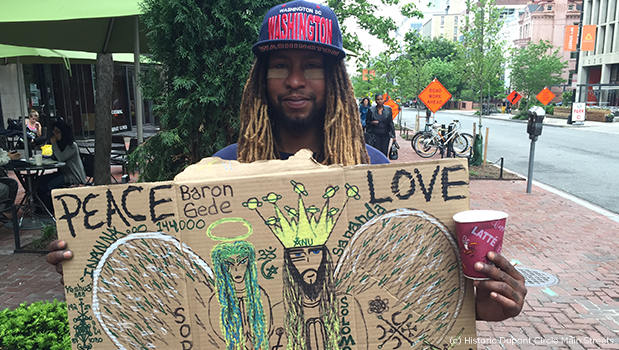
Lorenzo is very popular in the Circle.
While the barriers to ending homelessness are significant, Main Street managers can play a proactive role in addressing these issues downtown, while remaining attentive to the needs and concerns of all constituents. Like any other area of Main Street work, addressing homelessness begins with building relationships, leveraging partnerships, and helping to usher incremental change.
To recap…
1. Assess the homeless situation in your community
2. Educate the public, where possible
3. Learn about service providers
4. Support service providers
5. Petition the City for better services
6. Broker connections
7. Build relationships with homeless individual
8. Help those you can assist
9. Repeat, repeat, repeat…
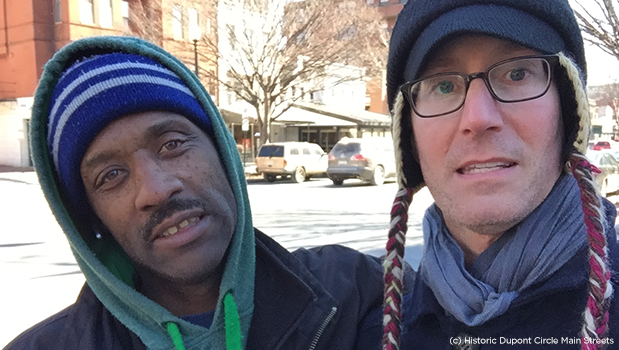
Rodney is off the street and in a house, and happier than ever!
Service Providers in the Historic Dupont Circle Main Streets Area:
Charlie’s Place
This independent charity uses a side room of a Lutheran church to serve homeless people for 30 years. Charlie’s Place provides breakfast Tuesday through Saturday, and haircuts and medical attention every Friday morning.
Foundry ID Ministry
This United Methodist Church provides support to obtain Social Security Cards and government identification cards for anyone—at no cost. People line up every Friday to start the process of tracking down their government identification.
Church of the Pilgrims Open Table
Every Sunday, this church provides lunch for homeless individuals by partnering with a nearby restaurant.
Street Sense
This newspaper is sold by homeless people for $2 each—75% goes to the seller. The paper is written by homeless people and sold by them to make money.
Central Union Mission
This is an old fashioned mission that provides overnight shelter, food, counseling, job training (Ready to Work—see below), and computer training.
Ready to Work
This is a job training program offered by Central Union Mission. RTW teaches trainees, mostly ex-offenders and homeless individuals, hard work, team spirit, and the value of a paycheck by sweeping the streets and landscaping public space.
Strive DC
This job preparation organization offers a three-week crash course in resume writing, interview skills, dressing for success, and even how to deal with your supervisor.
Pathways to Housing
This housing organization assists homeless people in getting off the street and into supportive housing, providing wrap-around services. Once people are housed, they stabilize, eat regularly, sleep securely, and can then real issues can be addressed.
Bill McLeod is the executive director of Historic Dupont Circle Main Streets. Bill works on fundraising, marketing, and management of the organization. Before that he was the Executive Director of the Mount Vernon Triangle Community Improvement District, a nonprofit business improvement district working on the east end of downtown Washington, DC–providing clean, safe, marketing, planning, and economic development services to the area. Prior to that, he was the Executive Director of Barracks Row Main Street, an award-winning nonprofit organization on Capitol Hill revitalizing 8th Street SE. Before that, he worked for the National Trust for Historic Preservation where he managed the Main Street Certification Institute, Great American Main Street Awards, and fundraised. Mr. McLeod earned his MBA through George Washington University and a B.A. in Social Science from Houghton College in Houghton, N.Y.